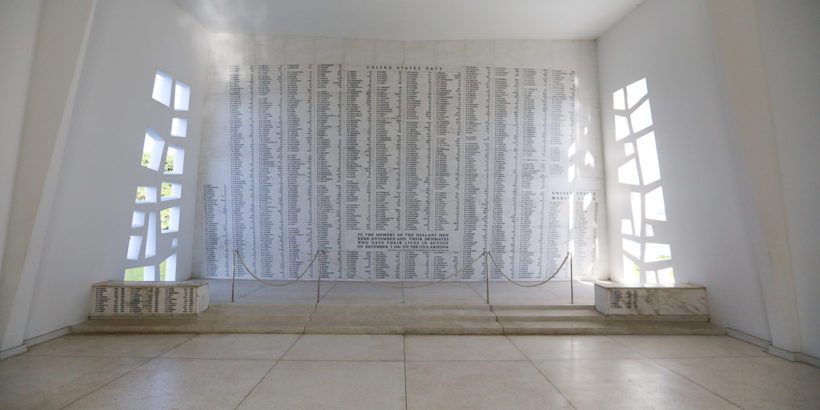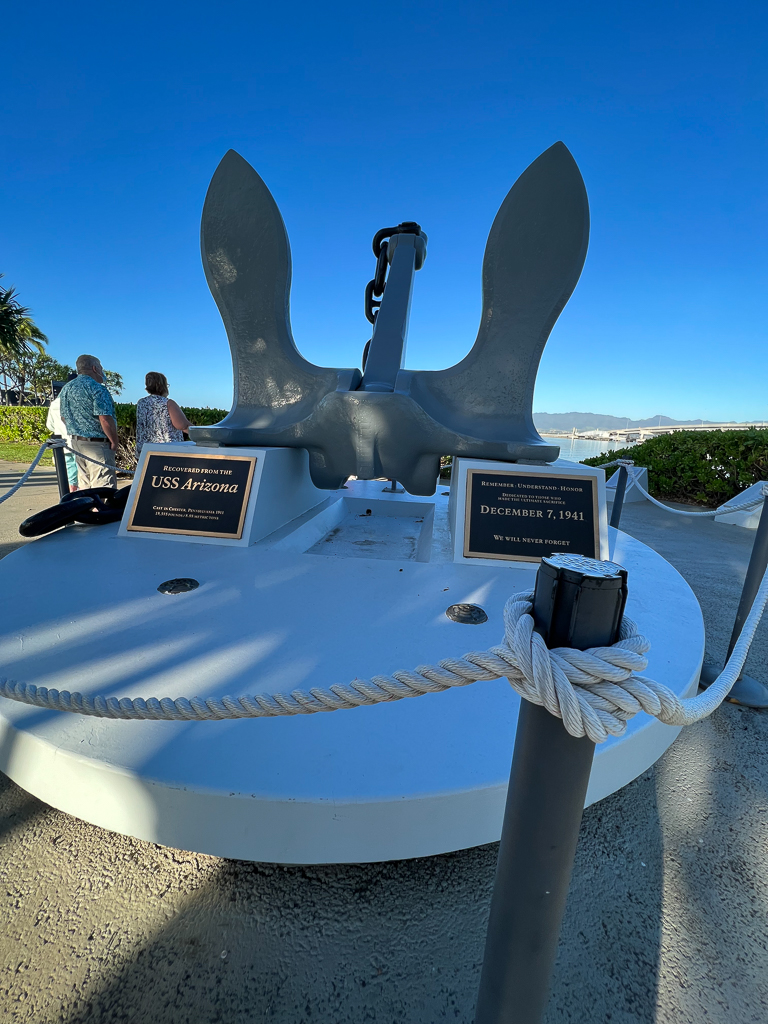1,177.
That’s the number of lives lost on the USS Arizona on the day that would forever live in infamy.
Today, the USS Arizona Memorial pays tribute to these lives lost and to all of the lives lost on December 7, 1941, during the surprise attack of Pearl Harbor.
Visiting the USS Arizona Memorial and making the most of your visit isn’t the easiest process because there are a few things you need to get in order before you arrive.
Below, I’ll give you all the information you need to know about the USS Arizona Memorial so that you’ll not only appreciate the magnitude of the site but also have the ability to make the most of your experience.
Table of Contents
What is the USS Arizona Memorial?
The USS Arizona Memorial is a memorial dedicated to members of the US Armed Forces who gave their lives during the attack on Pearl Harbor.
It’s built over the remains of the sunken battleship USS Arizona, the final resting place for 1,102 of the 1,177 crewmen killed during the attack on Pearl Harbor on December 7, 1941.
How to visit the USS Arizona Memorial
The USS Arizona Memorial is located in the waters of Pearl Harbor, which means that you will have to take a shuttle boat to access the memorial.
The shuttle boat trip is free but you must make a reservation online through Recreation.gov. (When you make a reservation you will have to pay a $1 reservation fee per person.)
You want to make this reservation as far in advance as you can because the time slots do fill up.
Time slots become available eight weeks in advance and a second batch of slots become available 24 hours prior to your visit.
So for example on January 1, tickets are released for January 2 and February 26.
The tickets will become available at 3:00 pm Hawaii Standard Time daily.
If you are unable to make a reservation there is a standby list that you can join (near the USS Arizona Bell Court) but during peak times that may not be available.
The tours at the USS Arizona Memorial start at 8:00am and go through 3:30pm daily. Each tour takes approximately 45 minutes from the time you step on the boat.
USS Arizona (brief) history
The USS Arizona (BB-39) came out of the Brooklyn Navy Yard and was christened on June 19, 1915 in odd fashion.
The newly added desert state had passed prohibition (five years before it became Federal law) and so many objected to christening the ship with a bottle of alcohol.
Sailors did not want to use a bottle of water since it was considered a bad omen and eventually a compromise was made so that both a bottle of sparkling wine and a bottle with water from Theodore Roosevelt Dam in Arizona would be used.
You can still see the bottles used for the christening at the University of Arizona.
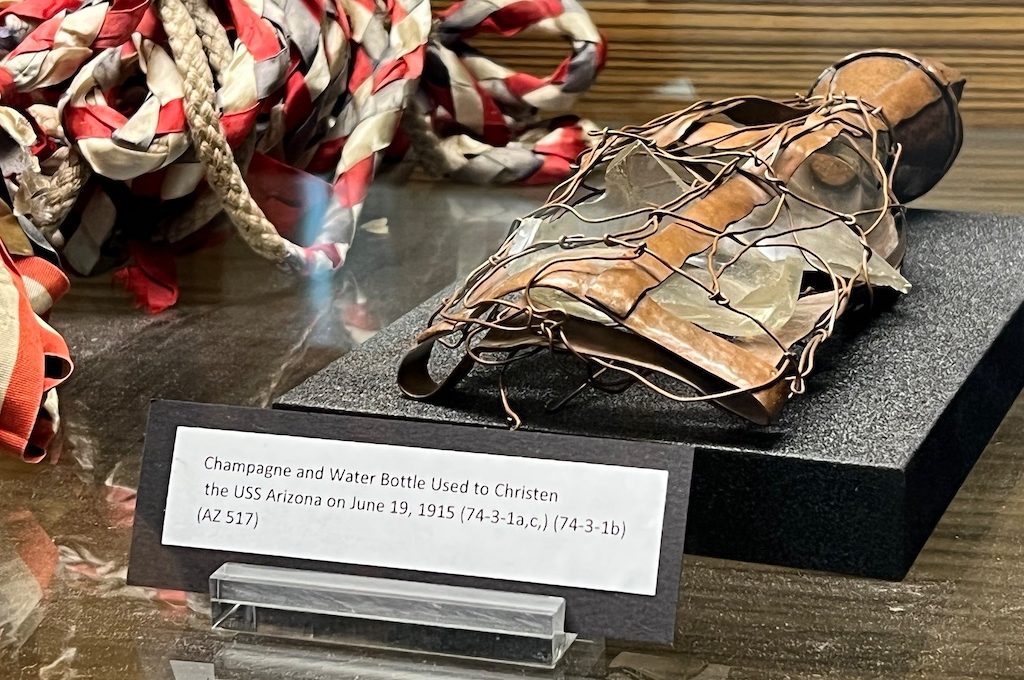
The Arizona remained stateside during World War I.
This was due in part to early issues the ship experienced and also to the fact that it ran on oil while other US ships headed to the European theater relied on coal which was more readily available.
But she did eventually make her way around the globe for various causes.
She participated in the escort when President Woodrow Wilson made his way to the Paris Peace Conference and in 1919 she spent time in Turkey at the beginning of the Greco-Turkish War before being transferred to the Pacific Fleet where she remained for the rest of her career.
The Arizona never fired any of her guns at any enemies and never participated in a battle until December 7, 1941.
Did you know? The Arizona achieved Hollywood fame in 1934 when she was featured in the movie, “Here Comes the Navy,” a romance starring James Cagney.
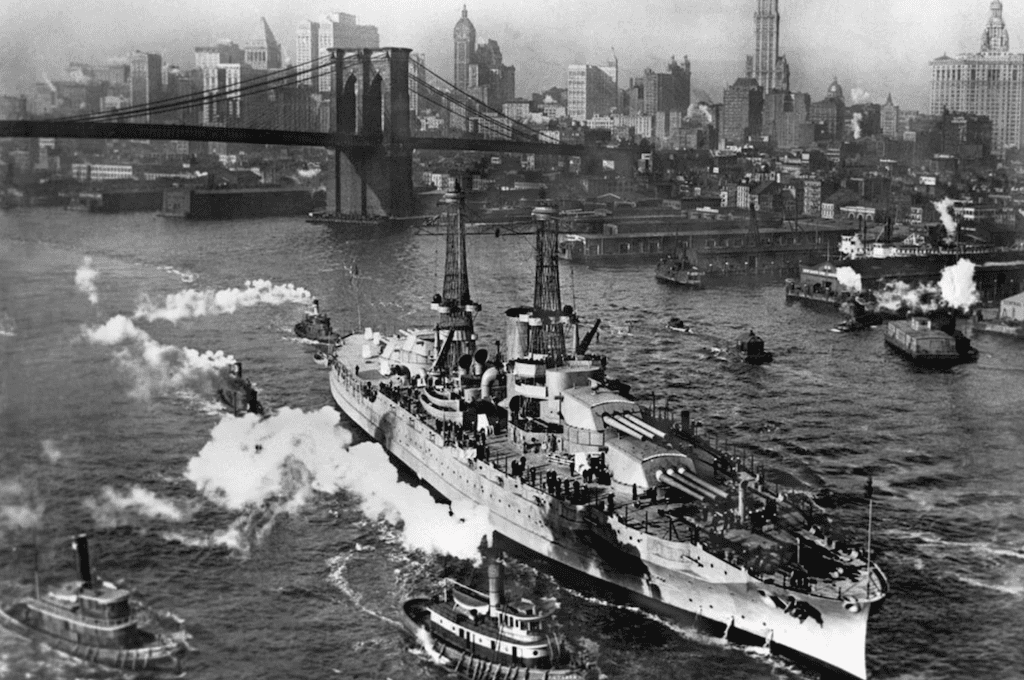
Leading up to the attack
The USS Arizona was not supposed to be in Pearl Harbor when the attacks occurred.
But on October 22, 1941, during a training exercise the battleship USS Oklahoma botched a turn and hit (some say torpedoed) the USS Arizona, creating a massive hole in its side.
The Arizona was forced into drydock for repairs and its trip to the West Coast was delayed which is why it was in Pearl Harbor on December 7.
Another eerie fact is that just one week prior to the attacks, the Arizona was featured in the annual Army versus Navy football game program.
There’s a caption that seems to foreshadow events to occur and states:
“A bow on view of the U.S.S. Arizona as she plows into a huge swell. It is significant that despite the claims of air enthusiasts no battleship has yet been sunk by bombs.”

The attack
On December 7, 1941, at about 7:55am, the Arizona’s air raid alarm went off as the attack on Pearl Harbor began.
Soon, 10 bombs were dropped by Nakajima B5N2 “Kates” and the Arizona sustained damage in different areas of the ship.
But it was at 8:06am near turret two when a bomb likely penetrated the armor deck near the magazines in the front section of the ship. About seven seconds after the bomb hit the forward magazines detonated and a catastrophic explosion followed.
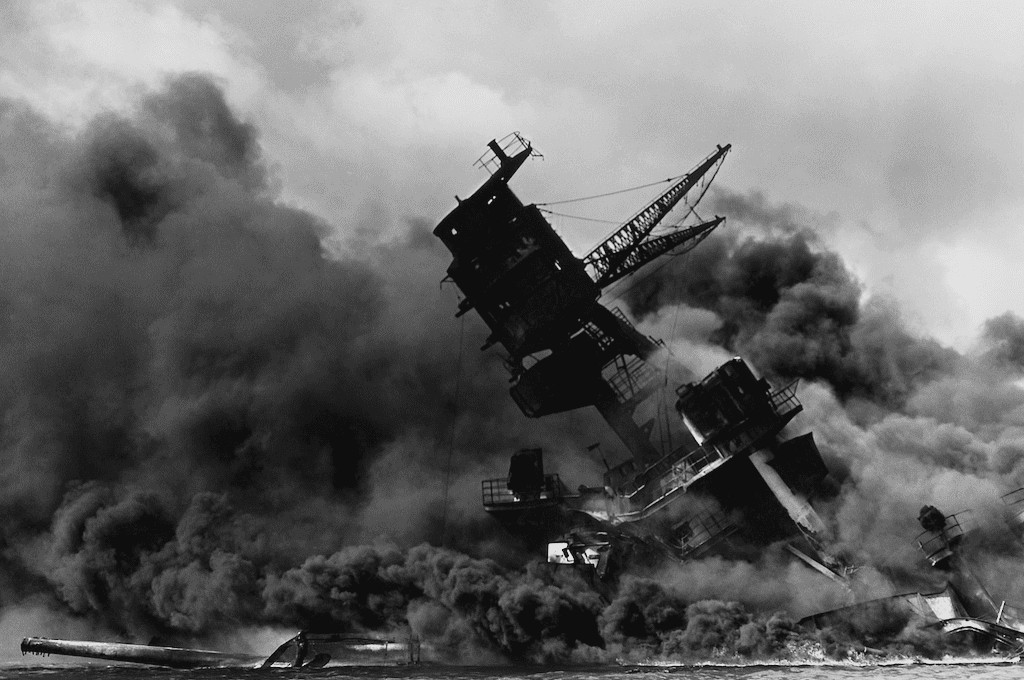
Fierce fires that would last for two days were set off and debris from the explosion showered down on Ford Island. The bombs and the great explosion killed 1,177 of the 1,512 crewmen who were on board at the time.
Salvage efforts over the next year would allow parts of the ship to be recovered and some of them were even used for battle later on like the guns from Turret II that were installed on the USS Nevada and used in the battle of Okinawa.
As for the men inside, after much deliberation, it was decided the men would be considered buried at sea because it would be too problematic to remove their bodies in a respectful manner.
Robert Ripley, of Ripley’s Believe It or Not! fame initially made efforts with the Navy to build a permanent memorial but his ambitions were a little bit too lofty.
Still, the Navy was committed to creating a memorial and The Pacific War Memorial Commission was created in 1949 to build a permanent memorial here.
In the late 1950s, after plans were slightly derailed due to the Korean War, fundraising took place to help create the memorial and money came in from all different sources, including a benefit concert from Elvis Presley.
Eventually, the memorial was designed by Honolulu architect Alfred Preis and was formally dedicated on May 30, 1962 (Memorial Day). Today, it attracts more than 1 million visitors each year.
Here’s footage from the dedication ceremony:
Making the most of your USS Arizona experience
If you want to bring out more from your experience and get familiar with a lot of the history behind the USS Arizona, there are four things you can check-out which would all be best to do before you depart on your boat to the memorial.
These four things are:
- Two Galleries
- Audio Tour
- Virtual Reality
- 23-minute film
Two Galleries (“Road to War” and “Attack”)
The two small galleries found outside the Pearl Harbor Memorial Theater take you through what happened during the attack and also provide you with some context leading up to the attacks.
There are quite a few interesting exhibits to check out that will help broaden your understanding of why the war started and also give you a better sense of who these sailors were.
For example, in the “Road to War” gallery, one of the most moving stories is of the USS Arizona band. On November 22, the Arizona band won the first semifinal of the “Battle of Music” competition.
The night before the attack, Dec 6, there was another competition round won by the USS Pennsylvania band. Having already secured a spot in the final, the Arizona band was there but just to watch.
On the next morning, the first bombs dropped with many of the band members preparing to play music for the daily flag raising ceremony.
They dropped their instruments and headed to their battle stations as ammunition handlers for turret two.
With their proximity to gunpowder and to the initial explosion, all of the band members perished.
The final Battle of Music round scheduled for December 20 was canceled and the Pennsylvania band awarded the trophy to the Arizona with a Latin phrase etched on the trophy meaning “such is the way to the stars.”

One of the most interesting and helpful exhibits in the “Attack” gallery is the scale model of the USS Arizona Memorial.
Take a look at it and maybe even snap a few photos from different angles because it might help you get a sense of what you are looking at once you get out to the memorial.

Audio Tours
One popular option is to do the Pearl Harbor audio tour which in addition to giving you a narrated experience on the USS Arizona, will walk you through other sites on the Pearl Harbor premises.
You’ll hear from the actual Pearl Harbor survivors and narration is done by actress Jamie Lee Curtis.
It’s about 1.5 hours long and you can purchase these audio tours for ~$8 right in front of the visitor center entrance. You’ll be issued a map and then you simply hit the number of the location when you arrive and sit back and listen.
Audio tours can also be found at the USS Bowfin and the Aviation Museum.
Virtual Reality
There are also virtual reality experiences that you can book.
There are different options for the virtual reality experiences and they are viewed with an Oculus. Each session costs about $8 and lasts about 6 to 8 minutes (they may be a problem for people prone to extreme motion sickness).
The VR experience was located at the Pearl Harbor Virtual Reality Center but due to the pandemic they moved outdoors next to the audio tour area.
The two new virtual reality tours include Air Raid Pearl Harbor and Skies Over Pearl. You can watch a trailer of them here but keep in mind that VR looks a lot different when you have a headset on.
23-minute film
At the Pearl Harbor Memorial Theater, they now once again play the 23-minute film presentation inside the theater before your boat tour to the USS Arizona Memorial.
The film gives an overview of the events leading up to the war with Japan and covers key aspects of the attack on Pearl Harbor, featuring powerful archival footage. Watching it beforehand adds important context to what you’re about to see at the memorial itself.
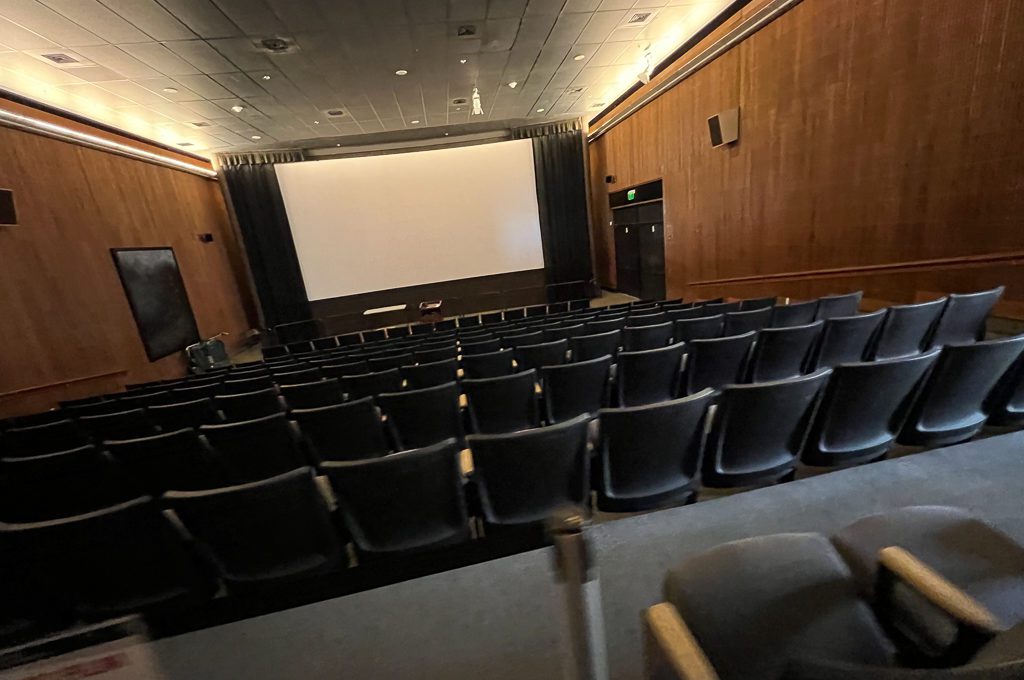
Experiencing the USS Arizona Memorial
Checking-in
About 10 minutes prior to your boat shuttle boat ride, you want to arrive at the check-in desk at the Pearl Harbor Memorial Theater.
It’s recommended to arrive at the park about one hour prior to your tour.
The USS Arizona Memorial check-in area is a covered area with a few benches so you can just sit and relax while you wait for everything to begin.

When time approaches for your tour, a park ranger will round everybody up and brief everyone on what they need to know about the memorial.
You really only need to know a couple of things.
The memorial is also a military cemetery so you need to act and dress accordingly. The biggest thing to remember is to just not be loud (and to not let your kids be loud/obnoxious).
When you first arrive at the memorial, you must keep walking until you actually enter the memorial. You are not allowed to stop for photos until you get inside of it so that you avoid causing a traffic jam.
After that briefing, you’ll be ushered to the dock where you will board the boat to take you over to the memorial.
Boarding
Your boat is manned by US Navy sailors and it is only about a 10 minute ride to the USS Arizona Memorial.

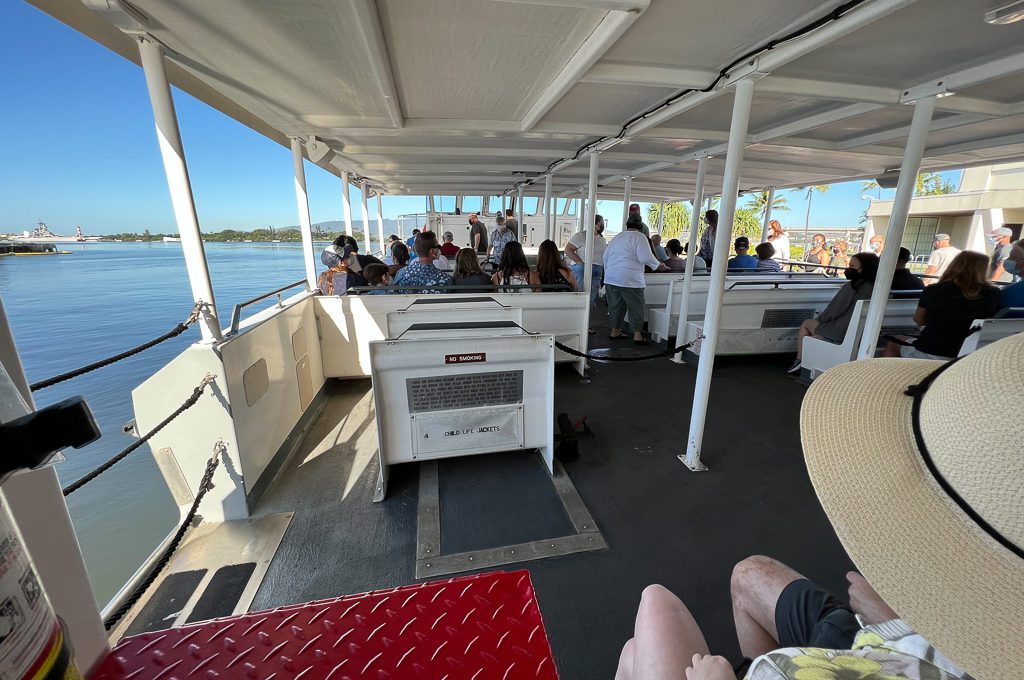
Once you’re in the harbor you’ll notice the mooring quays which are the last structures remaining from the attack on Battleship Row and named based on the ship that was located in that area at the time of the attack.
They were used to secure the battleships along Battleship Row and were actually an innovative way to secure lots of large ships in one area.
They also played a major role during salvage attempts and were “utilized as moorings for salvage ships, barges, and legs for ship-to-shore bridges and cross ship platforms,” according to NPS.


As you approach the memorial, you’ll notice its distinct shape.
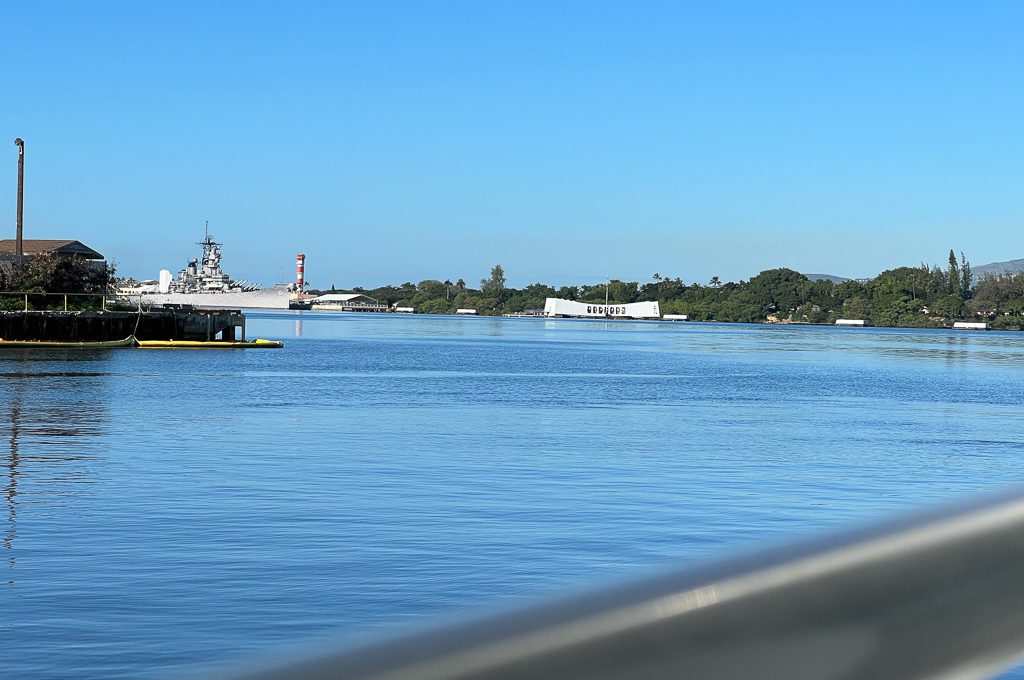
Critics initially were pretty hard on the memorial and said it look like a “squished milk carton” but there is symbolic meaning in the shape.
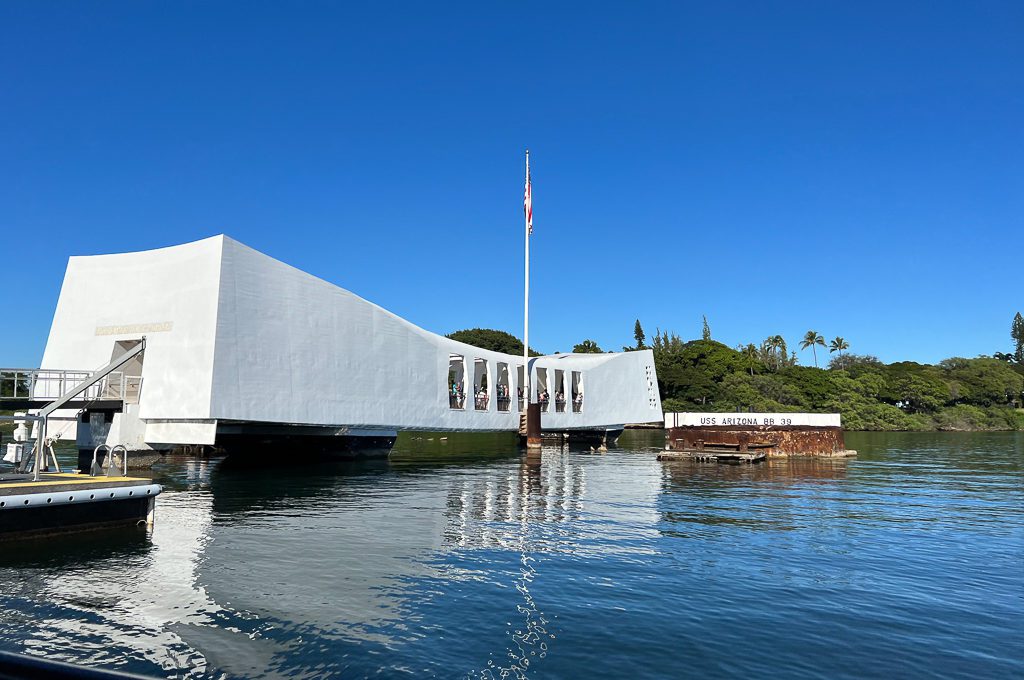
Each end of the memorial is rising up.
One side represents the pride that the US had before the attack on Pearl Harbor and the dip in the middle represents the pain experienced during the war.
The other side that rises back up represents the triumph the country experienced after victory.
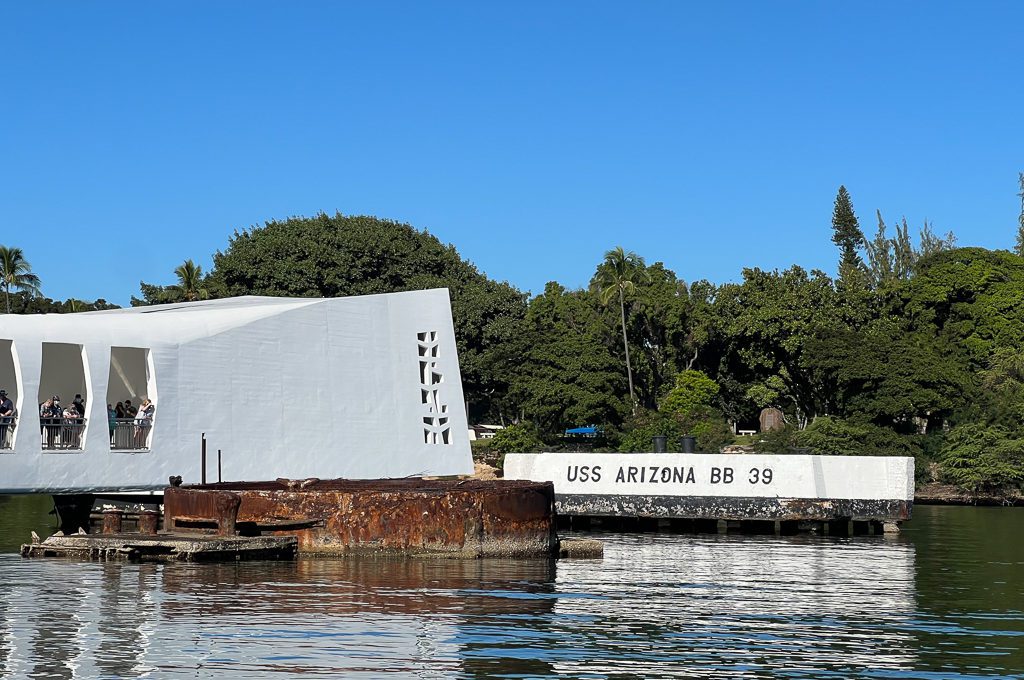
You’ll be impressed by how skillfully the Navy sailors parallel park as you arrive at the memorial. Listen to them and they will let you know when it’s time to stand up and exit the boat.
Once properly docked, you’ll then make your way to the memorial.
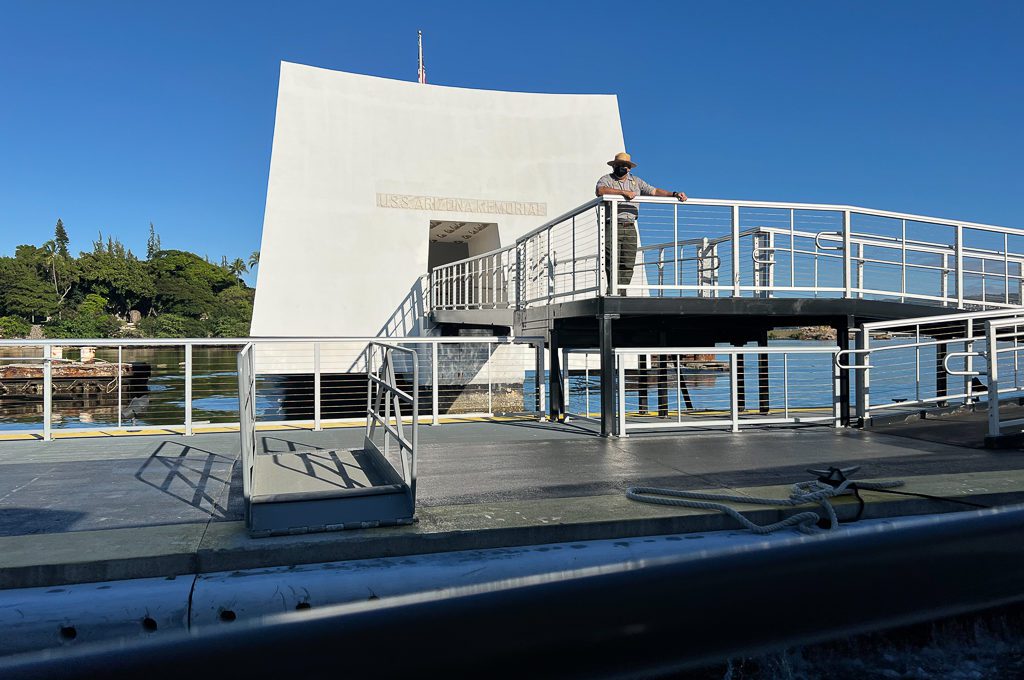
The shrine
Personally, I would recommend walking straight to the end of the memorial where you’ll find the shrine.
Most people don’t go to that area until after they explore the first part which means that you can have that area to yourself.
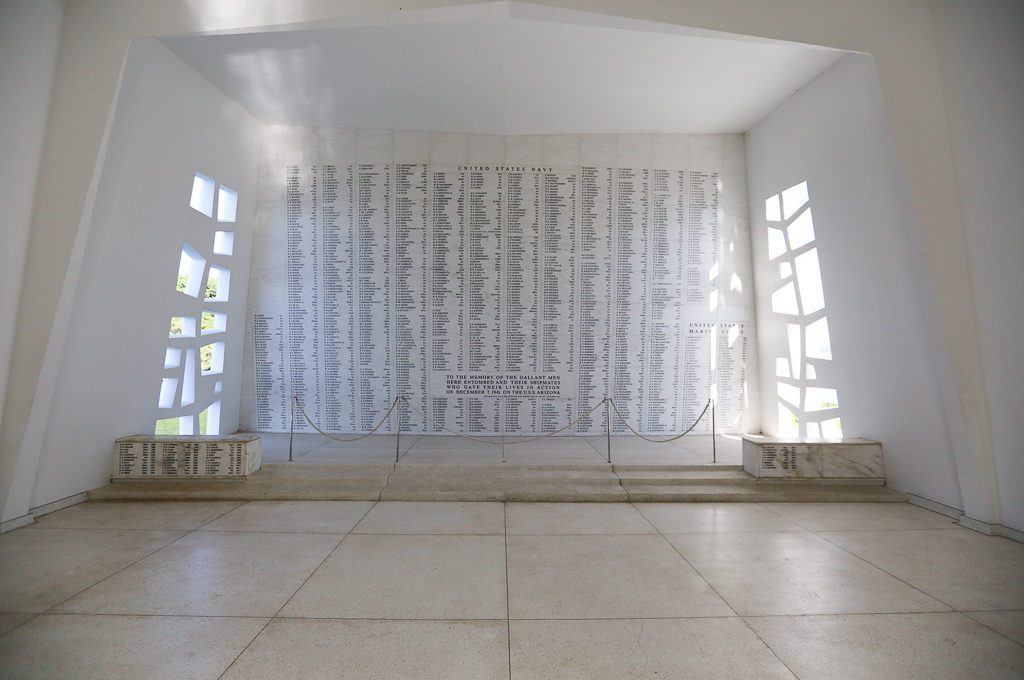
Not only can you get better photos but you can have a more intimate experience with that part of the memorial.
The shrine has all of the names of the sailors and marines who were killed on the USS Arizona.
It reads:
“To the Memory of the Gallant Men Here Entombed and their shipmates who gave their lives in action on December 7, 1941, on the U.S.S. Arizona.”
Something that always gets me is knowing that of the 79 individual brothers on the Arizona, 63 died.
There were three sets of three brothers: the Beckers, the Dohertys, and the Murdocks but only one from each set survived.

On the sides of the shrine, you’ll see names of those who have been interred within the ship and those dates.
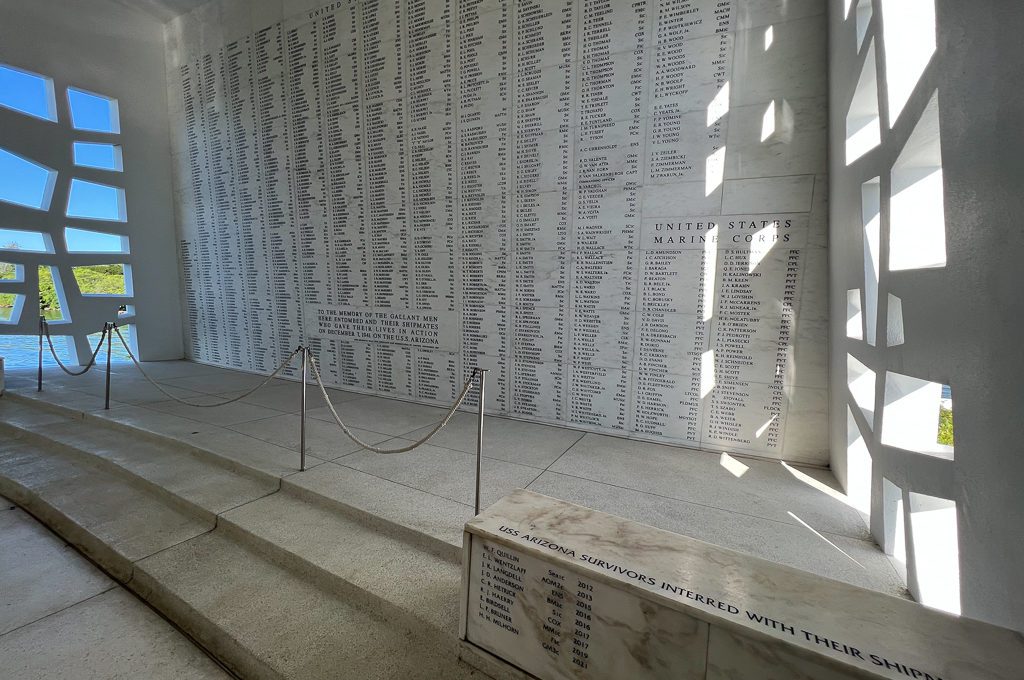
Those who were on the ship during the attack can choose to have their remains placed inside the ship’s well of barbette number four by a scuba diving team.
(Others who were Pearl Harbor survivors are allowed to have their ashes spread on the surface of the water in Pearl Harbor.)
The Arizona burial ceremonies involved a full military funeral and were very moving but it doesn’t look like that last remaining survivors plan on being buried this way so we may have seen the last of these ceremonies already.
Below, you can see what ceremony would look like.
As you admire the shrine, you’ll also notice the designs in the walls.
These are known as the tree of life and they represent a symbol of renewal. In my opinion, they add a lot of beauty to the memorial.
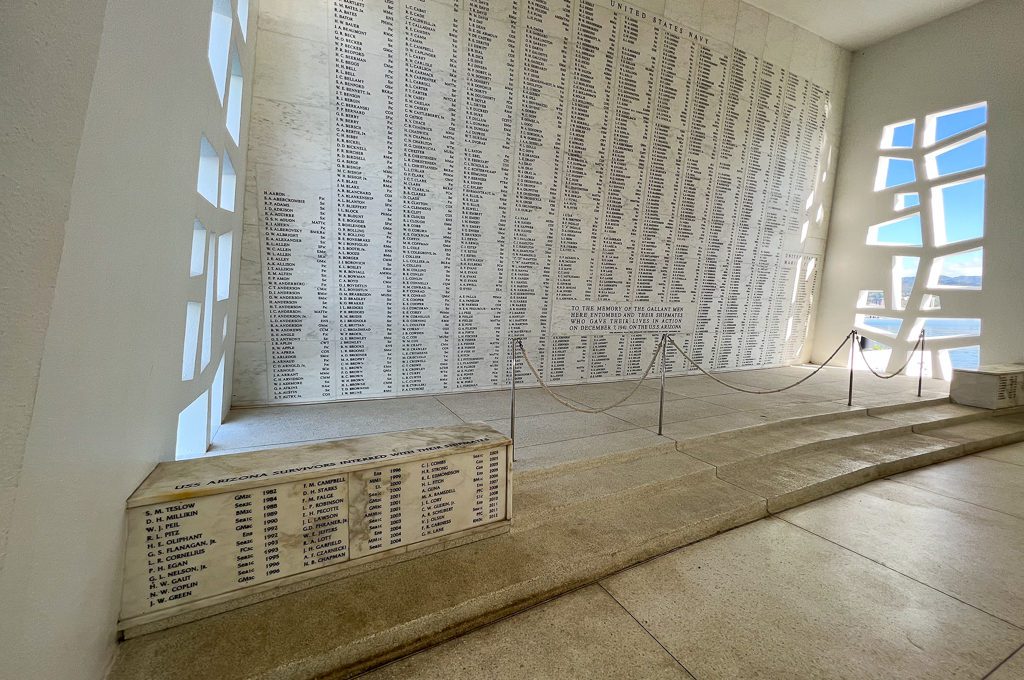
You can also find one of these back where you came from at the visitor center.
Viewing well
After checking out the names, you can then explore the other part of the memorial: the central assembly room.
Coming out of the shrine, you’ll see a large opening that looks directly down into the ship. This is the viewing well and is a place where people leave flowers for those being remembered.
If you want to leave flowers, it’s best to run it by the park ranger when you arrive.
They should not have a problem with it but they might want to make sure you’re not dropping anything down there that could affect wildlife (e.g., string from a lei).
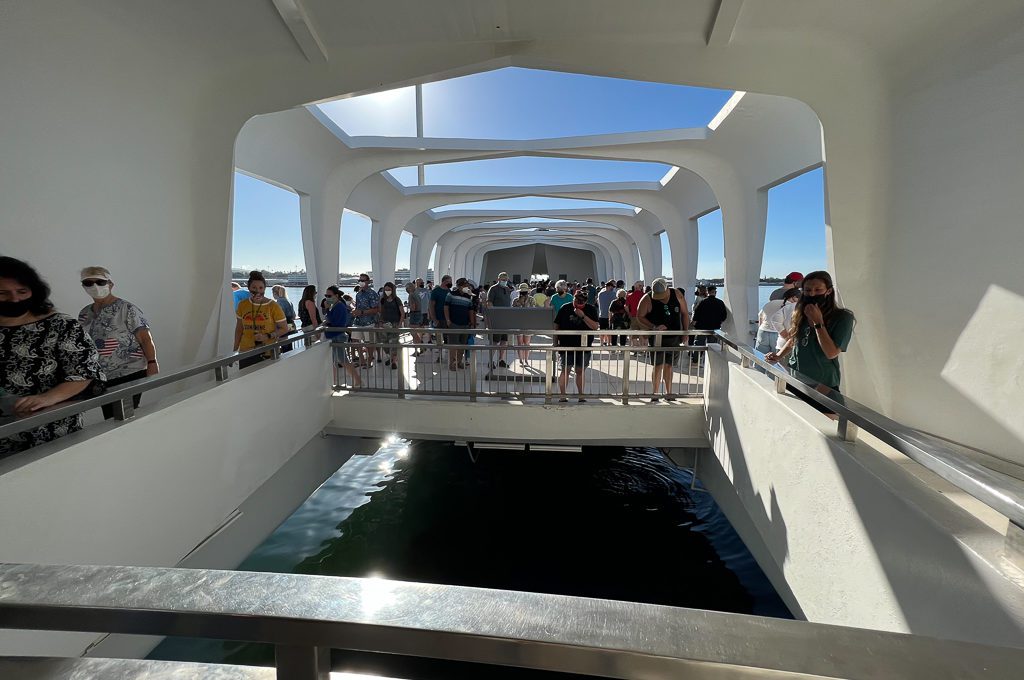
From the surface of the water to the bottom it’s about 40 feet but part of the ship is directly beneath you here.
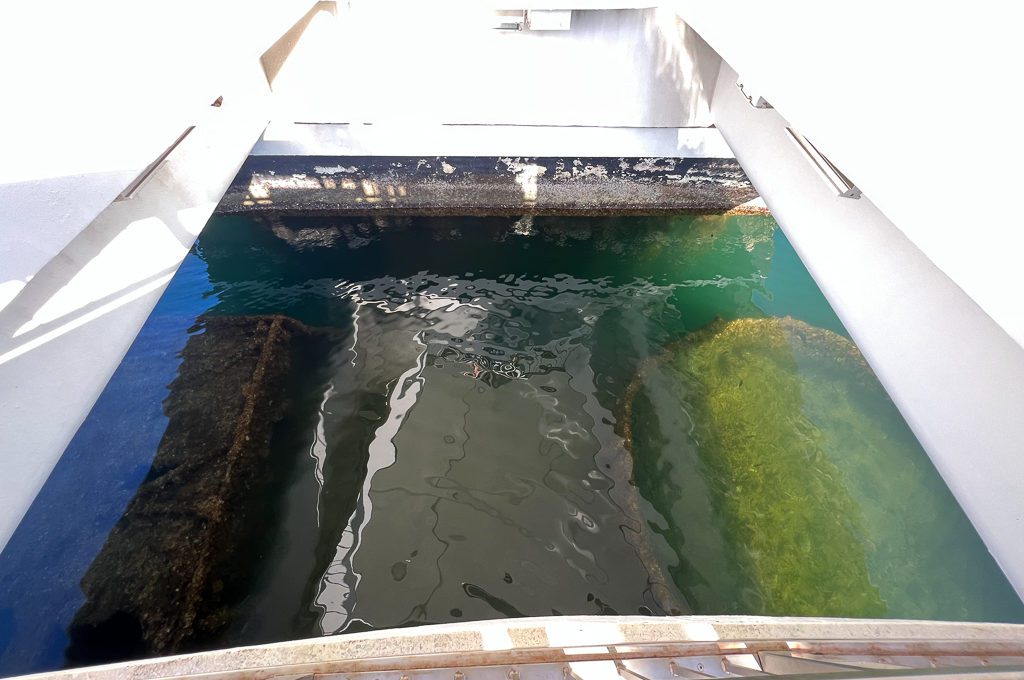
Number 3 barbette
When you look towards Ford Island Bridge, you’re looking towards the rear (aft) of the ship and you’ll see a rusted circular structure that rises just above the water’s surface.
This is no. 3 barbette and it’s where one of the four turrets with 14″ guns was located.
Turret number one which was at the front of the ship is the only turret still intact but it is on the deck that was blown up and so it dropped down and is now completely submerged.
Tip: If you took a picture of the model found in one of the galleries, you can refer to that to make out the different structures you’re looking at.

Marine life
While looking out at the ship’s remains, you might spot wildlife including various types of fish.
We were greeted by a friendly little sea turtle during our visit but beneath the surface a lot of wildlife flourishes like brown seahorses, sponges, coral, and even spotted eagle rays.

The 7 windows
Looking around, you’ll notice seven wide openings on both sides of the memorial and on top. The number seven is symbolic for December 7, the day of the attack in the US (the attack occurred on December 8th in Japan).
The seven total windows on each side and on the ceiling come out to a total of 21. Some say this is symbolic of the ever-present 21 gun salute for the fallen although it’s disputed that the designer had that in mind.
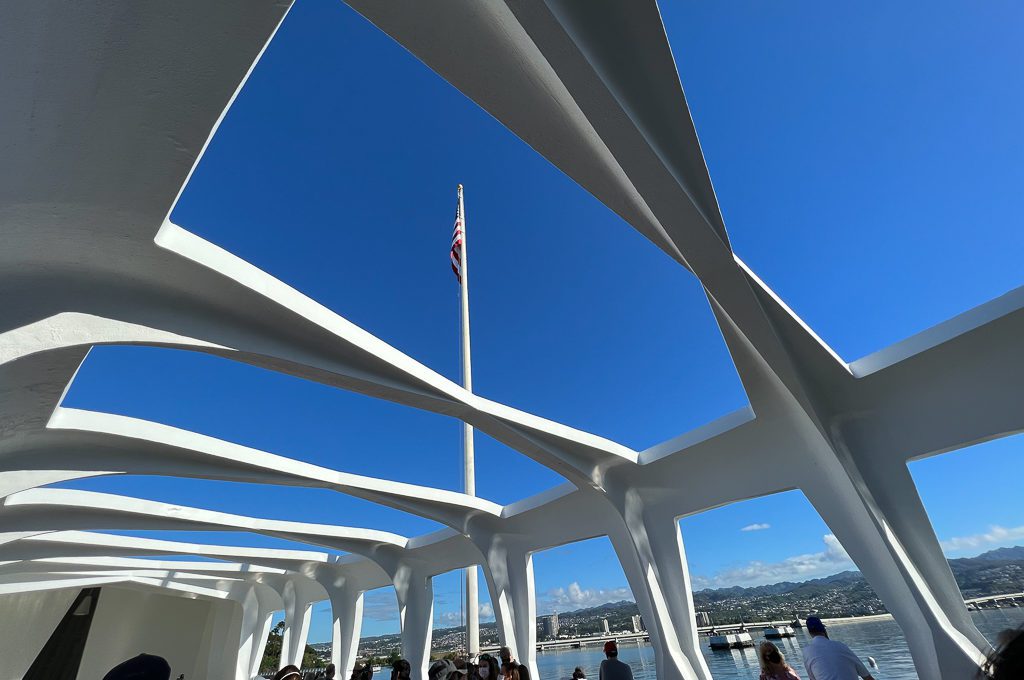
The flag
You’ll also notice the flag that might be waving if you have a breeze coming through. This flag is actually attached to the severed mainmast of the USS Arizona — something that began in 1950.
It was in that year that the first temporary memorial was built above the remaining portion of the deckhouse but due to the ongoing expenses for the Korean War at that time the memorial was not a priority.
Related: National Mall in Washington DC (1 Day/24hr Itinerary)
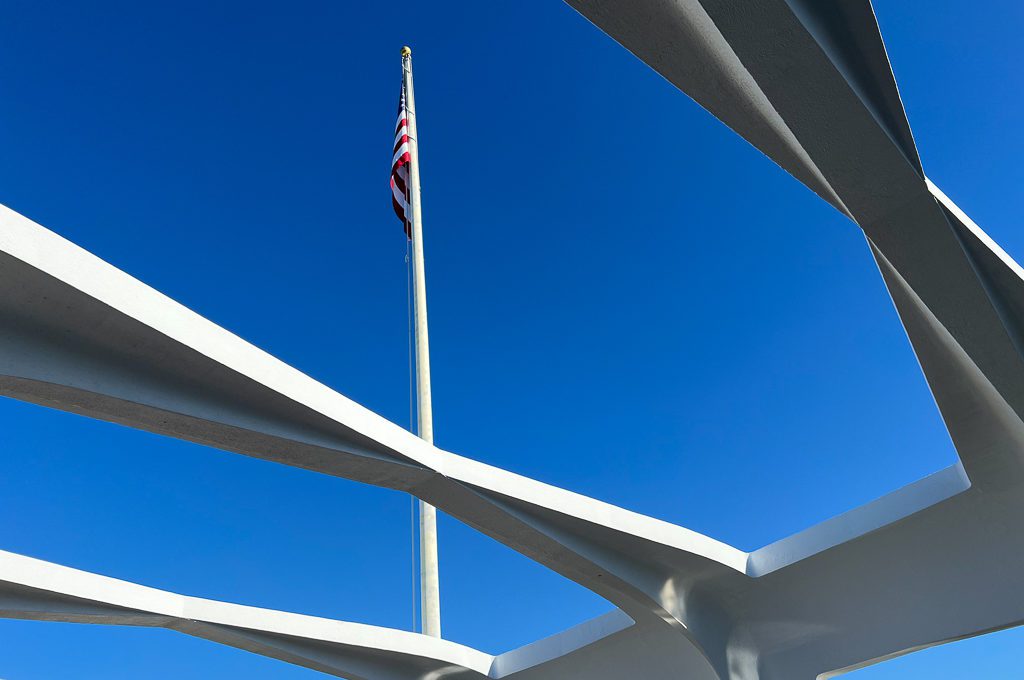
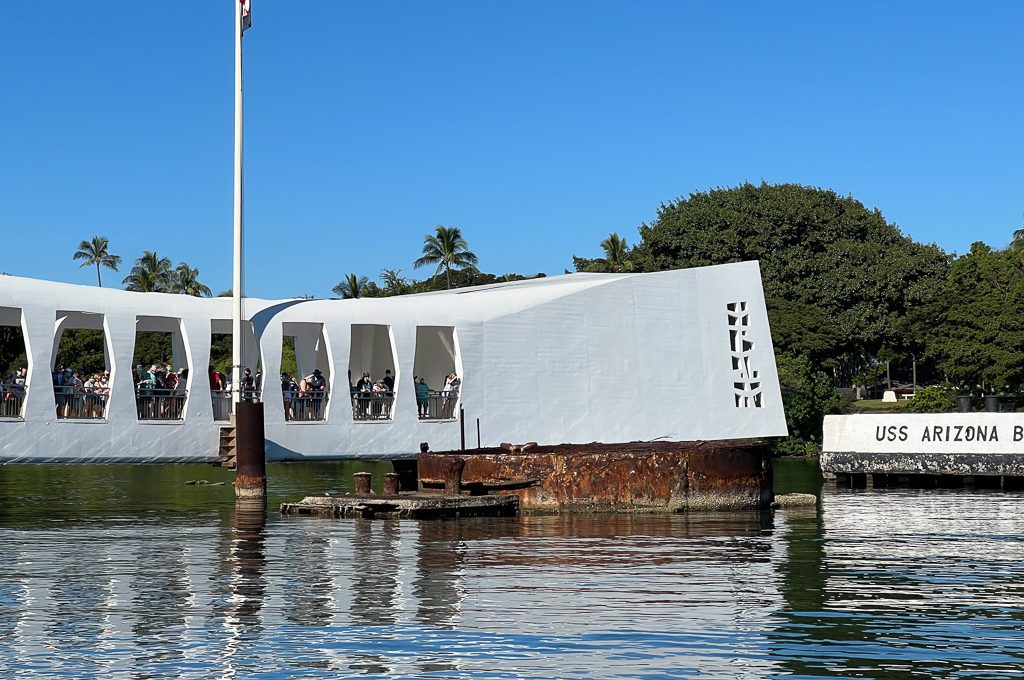
The USS Missouri
The USS Missouri sits across the remains of the USS Arizona and if you look closely at it you can see that its guns are aimed over the USS Arizona.
This placement is a symbolic gesture with multiple layers of meaning.
It shows that the Missouri is looking over all of the fallen from the USS Arizona and it also represents both the beginning and end of World War II.
The beginning of course was the attack on Pearl Harbor and the end occurred when the Japanese signed the surrender instruments on Surrender Deck aboard the USS Missouri (which you can visit today).
Related: USS Missouri “Mighty Mo” Review
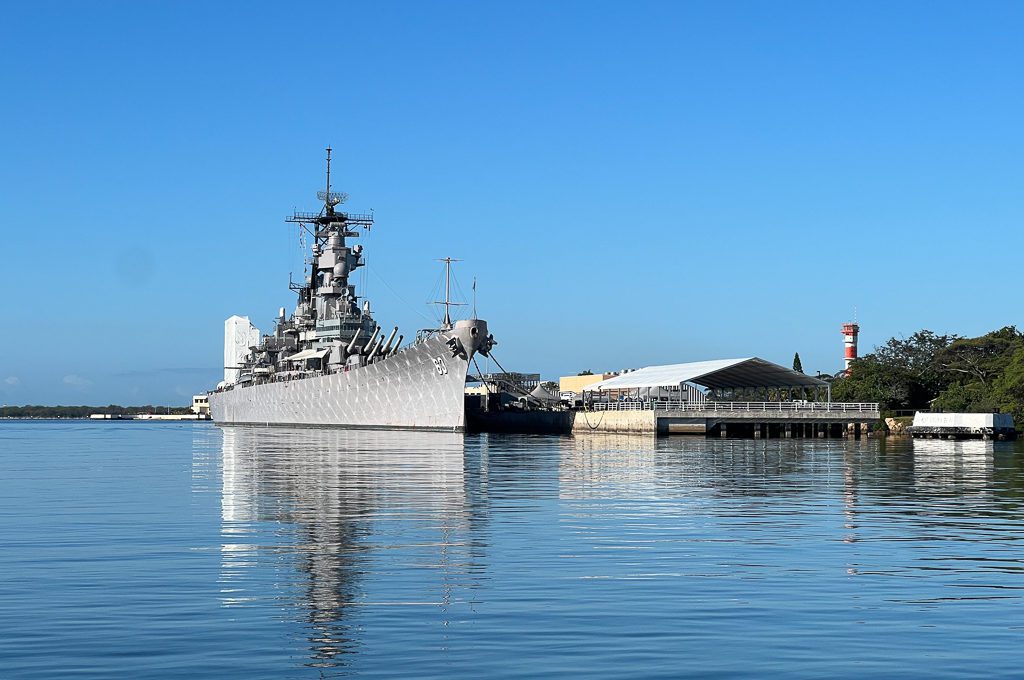
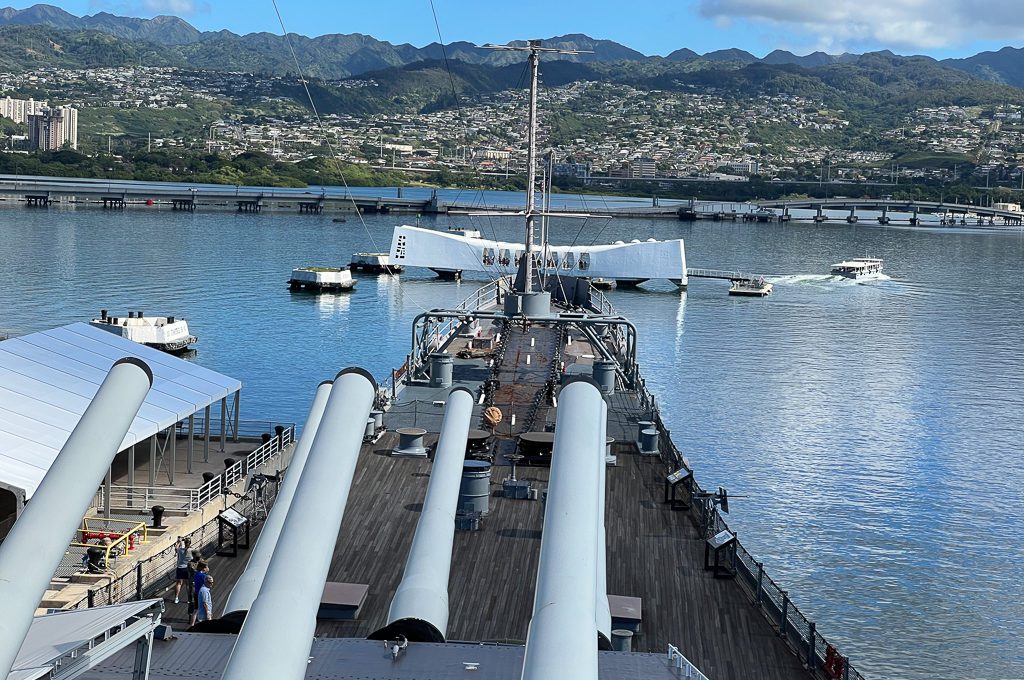
“Black tears”
At some point, you’ll probably notice oil on the surface of the water. You might even watch bubbles arise from the murky green depths.
The oil is known as the “black tears” and it is oil actively leaking from the USS Arizona, as it has done for 8 decades. Read more about the oil leak here.

In 2018 it was estimated that there was still 500,000 gallons of oil down there and right now approximately 9 quarts leak every day.
The National Park Service is monitoring the environmental impact of the oil. In the event of a major leak, they will likely take action to mitigate or stop the leaks.
Ranger led discussion
During your visit, there may be someone such as a park ranger on the memorial to give you stories and answer questions. There was a good size group huddled in the middle of the memorial just listening to different stories.
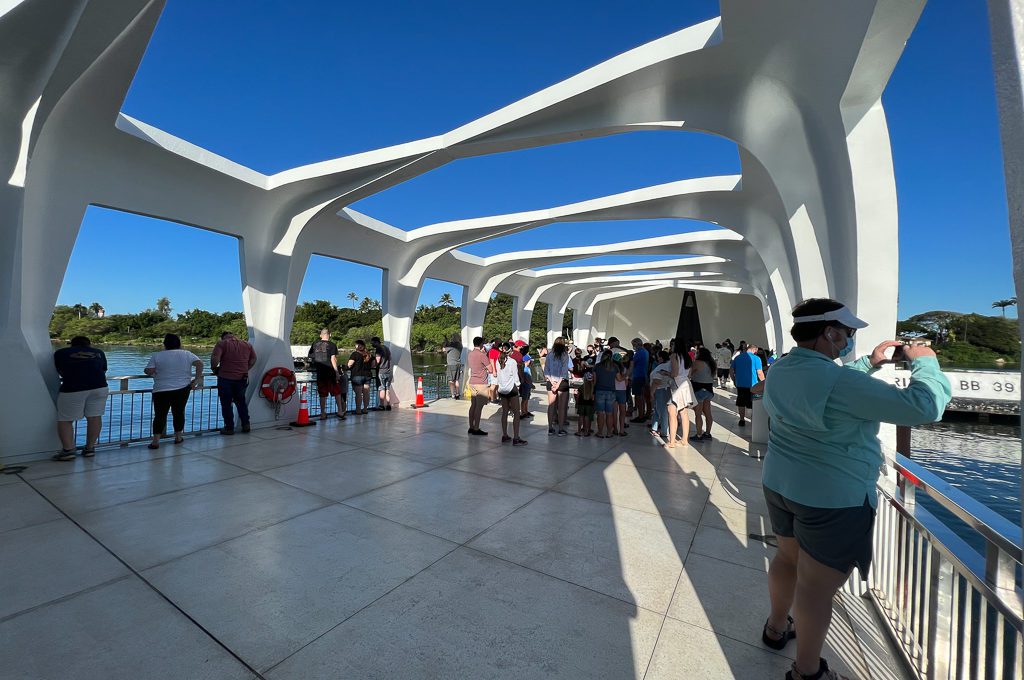
Once you have seen everything you can then head back to the entrance area where people will be lining up for the boat ride home.
You can check out the plaques on the wall in case you missed them whenever you entered.
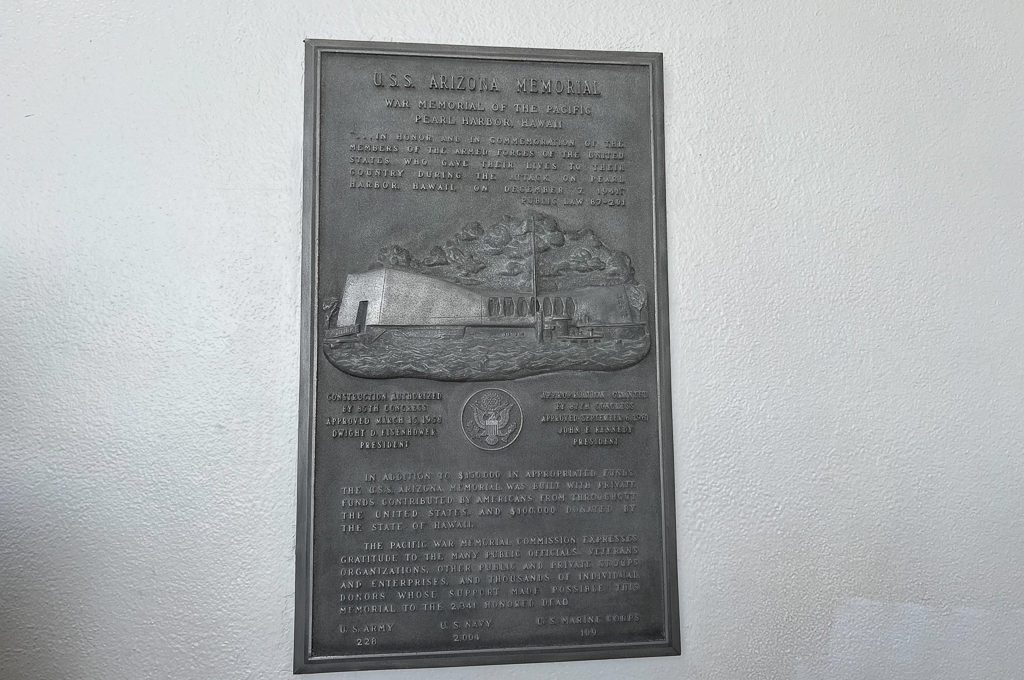
You’ll wait for the incoming passengers to disembark and then make your way back to the boat.

If you’re lucky, you might see a navy ship coming through.
Something cool about the Navy ships that pass through Pearl Harbor is that they all “man the rails” and pay their respects to the Arizona when they come in or out of harbor. This gesture is found in the symbolic design of the USS Oklahoma Memorial.
You can see what it looks like when the sailors man the rails for Pearl Harbor below.
Other sites not to miss
Before you depart the Pearl Harbor Visitor Center, make sure that you also check out two artifacts from the Arizona.
The first is the USS Arizona Bell which is found right by the theater where you check in for the USS Arizona boat shuttle. It’s also where people wait while on standby.
This is one of the two bells from the ship and the other bell is currently at the University of Arizona campus in its clocktower which we visited right before we visited Pearl Harbor.
At the clock tower in Tucson, AZ, they symbolically ring the bell seven times the third Wednesday of every month at 12:07pm.
The other thing to check out is the massive anchor from the USS Arizona.
Final word
The USS Arizona Memorial is the prime attraction at Pearl Harbor and perhaps in all of Hawaii for many. It is a solemn occasion when you visit but it’s also a time to reflect proudly on the bravery and sacrifices that thousands made during World War II.
To get the most out of your visit you want to plan ahead and also think about visiting some of the additional galleries, and trying out the audio tours or even the virtual reality sets as they will broaden your understanding of the events that took place and allow you to appreciate what all of those involved truly went through.
Daniel Gillaspia is the Founder of UponArriving.com and the credit card app, WalletFlo. He is a former attorney turned travel expert covering destinations along with TSA, airline, and hotel policies. Since 2014, his content has been featured in publications such as National Geographic, Smithsonian Magazine, and CNBC. Read my bio.

